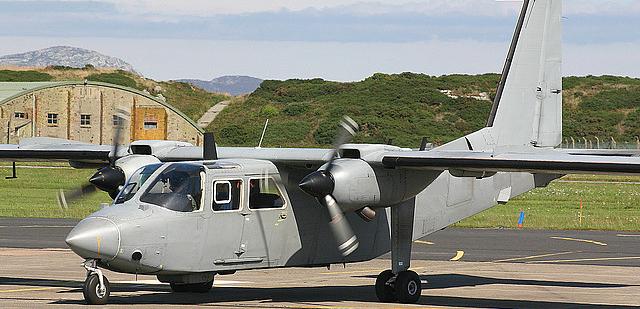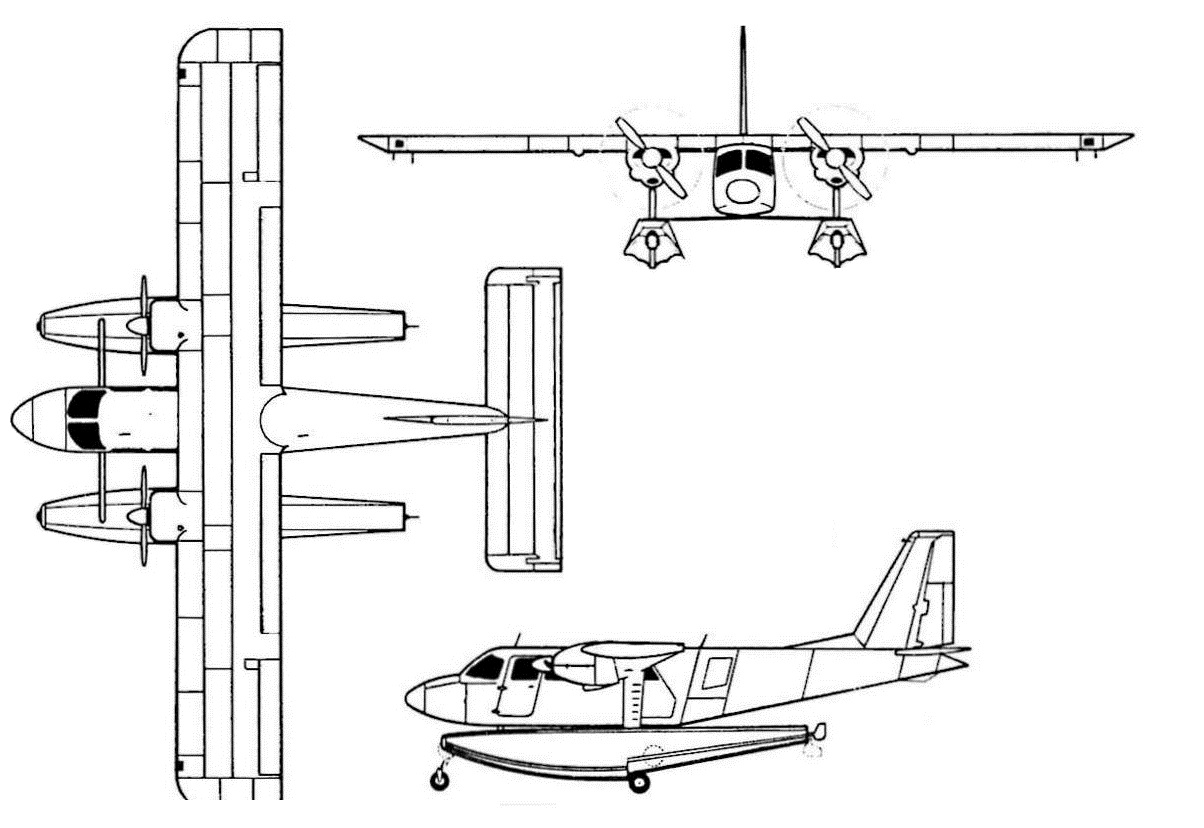 | Britten-Norman
BN-3 Islander |  |
|---|
| Terran United Nations. | Terran United Nations. |
|---|
Design of the Islander started in 1963 and the first prototype BN-2 first flew on 13 June 1965, with the second prototype following on 20 August 1966. Both of these had engines that were less  | | A Britten-Norman BN-3 Islander In Service With The Greater Caribbean Security Group, A UEG-Allied Collective Of The Carribean States. |
|---|
 | | A Britten-Norman BN-3 Islander Seaplane Variant. |
|---|
powerful than the production versions. The first production Islander first flew on 24 April 1967.
An improved version, the BN-2A, first flew in 1969. It incorporated aerodynamic and flight equipment improvements as well as changes to the baggage arrangements.
In 1978 a further improved version, the BN-2B Islander II was introduced. Improvements included an increased carrying capacity and propeller modifications to reduce noise levels. Options that were available include a long-nosed version for increased baggage capacity, raked wingtip auxiliary fuel tanks and twin Allison 250-B17C turboprop engines. When the latter are installed the aircraft is designated as the designated the BN-2T.
An attempt to develop an Islander with an even larger capacity resulted in the BN-2A Mk III Trislander. This aircraft has a stretched fuselage, modified landing gear and a third (tail-mounted) engine. The prototype was constructed from the original second BN-2 prototype and flew on 11 September 1970. A number of other companies have also manufactured the Islander in addition to Britten-Norman. URMA from Romania has been building the aircraft since 1969, while a factory in Gosselies, Belgium has been building it since 1973. The aircraft has also been assembled in the Philippines.
During the First AND Second Terran Reconstruction, a large fleet of basic transport aircraft were needed to haul people and things from place to place cheaply. For reasons that still are not clear, the BN-3 was selected during the First Reconstruction. It was selected again during the Second Reconstruction due to the fact that it had been used and proven capable once before, and because the REF had blueprints in hand. Though no longer subsidized by the Terran Authority, the BN-3 remains in wide-spread service, with over 10,000 units built annually at peak production, and more units still rolling off the assembly lines (though at a far slower pace).
The only significant changes made by the REF were the installation of grav pods (as an auxiliary flight system) and hydro-cell turbo props, both necessitated by the REF's logistical requirements (grav pods were necessary because the REF often operated out of areas where VTOL capabilities were paramount).
Name: Britten-Norman BN-3 Islander.
Model Type: General cargo and personnel delivery.
Designation: BN-3
Crew: One or two pilots.
Passengers: Up to nine.
SDC By Location: This is not, nor ever was meant to be, an MDC Structure. No upgrades are commercially available to make it an MDC Structure. |
* Fuselage-
** Cockpit-
*** Engine Nacelles (2)-
*** Wings (2)-
*** Tailerons (2)-
*** Tail Rudders (2)- | 1,000
500
100 each
100 each
75 each
50 each | Props (2)-
*** Grav Pods (30)-
*** Variable Full-Force Barrier Fields (2)-
Landing Struts (10)- | 100 each
500 MDC (this and the force feilds are the only MDC object in the plane)
1,000 each (this and the grav pods are the only MDC object in the plane)
100 each |
Notes:
* Depleting the MDC of the fuselage of the aircraft will destroy it.
** Depleting the MDC Cockpit will expose the pilot to high-velocity winds and further direct attacks. However, the pilot may remain protected by his body armor. (Winds won't affect him if the face mask is in place.)-5 to strike.
*** Depleting the MDC of any of these objects will reduce the pilot's control (-10% to pilot skill each). The are also small and hard to hit (requires a called shot at-5 to strike). Destroying ALL 3 grav pods will force the pilot to pilot the craft on airfoil effect ONLY (-5% to pilot skill, but does not mean s/he will crash land).
Speed and Statistical Data: |
Taxiing on the ground: 10 MPH
Range On Land: About 1 mile normally; 10 miles max.
Flying: 170 mph (273 km/h)
Service Ceiling: 13,200 ft (4,024 m)
Climb Rate: 970 ft/min (295 m/min)
Range in the air: 875 miles (1,400 km); Can be refueled in the air with an upgrade kit.
Height: 13 ft 9 in (4.18 m)
Wingspan: 49 ft 0 in (14.94 m)
Length: 35 ft 8 in (10.86 m). | Weight: 6,600 lb (2,993 kg)
Cargo: Passengers or up to 100 tons. All crewmembers must wear flight armor when flying.
Power and Thrust System: Twin Dual Aeration Lycoming O-753-G4A; Output: 35 hp at 195 kW
Flight Systems:
Primary: Aero-Foil effect and Thrust Systems.
Secondary: Grav pods.
Cost and Availability: 1 million credits each; 6 months to build.
Black Market Cost and Availability : Between 1/4 to 100 million credits each, depending on buyer and seller; Stolen or captured ones are fairly regularly available, but is mostly a special request item. |
Defensive Systems:
The Islander has no weapons per se, and very limited defensive features; This really isn't meant as a combat craft. |
1. Full-Force Barrier Field: A Full-Force Barrier Field provides some protection for the craft.
Purpose: Defense.
MDC: 200 available.
Effect: Provides 200 MDC.
Range: 10 ft.
Coverage Characteristics: A full 360 degree coverage area around the craft.
2. Radar Detection/Warning Receiver: Providing all aspect broadband protection from RF guided missiles.
Purpose: Detection, Identification, and Tracking.
Sensor Type: Radar detector.
Effect: Detects all radar signals contacting the craft, even if the signal is too weak to successfully return to point of origin.
Range: Surface of craft.
Minimum Target Characteristic: Any radar signal.
Coverage Characteristics: A full 360 degree area.
3. Grumman QCR-842 Infra-Red jammer: An active infra-red jamming system that "floods" the surrounding area with false IR image; Appears on IR sensors as a big, semi-fluid glob.
Purpose: IR jamming.
System Type: Defensive.
Effect: Creates semi-fluid glob of approximately 1003 miles.
Range: Approximately 1003 miles.
Coverage Characteristics: A full 360 degree area. | 4. Griger-200RT Active Missile Jamming System: Creates several different fields of false active and misleading signals that missiles then fall into; Enemy missiles may prematurely detonate, or become confused and think they're off-target, when in fact they aren't.
Purpose: Anti-Missile Defense.
System Type: Active.
Effect:
01-50: The missile thinks it's off-course, and will attempt to correct; Re-roll strike at-10.
51-00: The missile thinks it's reached the target and detonates; If it is sufficiently close enough for blast area effect, re-roll as below:
01-45: Missile does no damage.
46-90: Missile does 1/4 damage.
91-00: Missile does 1/2 damage.
Range: Begins effective coverage at 100 miles.
Minimum Target Characteristic: Missiles.
Coverage Characteristics: A full 350 degree area.
5. Smoke Dispensers (40): Throws out smoke flares capable of covering a 250 cubic ft area. Special chemicals in the smoke obscures IR and heat sensors, and defeats visual tracking of the vehicle. Note that it DOESN'T make the vehicle invisible, but simply negates ALL bonuses to strike.
Purpose: Obscuring the craft for a few moments.
System Type: Active Defense.
Effect: Creates a cloud of smoke that covers a 250 cubic ft area.
Range: A 2503 ft area.
Coverage Characteristics: A full 360 degrees. |
| Features: |
- Radar: Civilian grade radar. Range: 100 miles, can track up to 200 individual targets. 90% reliability (00% against unfriendly stealthed vehicles).
- ESM: Radar Detector. Passively detects other radars being operated.
- Grav Pod Equipped Landing Struts: Miniature grav pods are installed in the landing struts to adhere to ships, etc, in space. The grav pods are NOT strong enough to hold the EC-66 to a building on a planet, but will hold it to the hull of a ship in space. Also can be used during taxiing.
- Motion Detector: Activates a loud wailing when an object is coming at the user fast, and a soft ringing if it's coming slowly. Activation ranges must be specified by the pilot.
- Video Recorder: Records from sensors and the cockpit itself. 500 hours of recording available.
- Type-11 wide band radios: Effective 10 mile range, auto encrypt/decrypt. Works on standard radio band wavelengths, so it can still be jammed (if the enemy knows the frequencies).
- Electronic Counter Measures (ECM): These systems disrupt enemy radar and tracking systems, making it difficult for them to lock onto the ship with weapons. The countermeasures give the Mecha a +3 to dodge, +2 to strike and +1 on initiative in combat.
- Internal temperature and humidity control: Automatically maintains users desired heat, humidity, and other personal comfort settings.
| - GPS: Standard tracking device.
- Smoke dispensers (8): Throws out smoke flares capable of covering a 250 cubic ft area. Special chemicals in the smoke obscures IR and heat sensors, and defeats visual tracking of the vehicle. Note that it DOESN'T make the vehicle invisible, but simply negates ALL bonuses to strike.
- Full-Fuselage Inflatable Floatation: A self-inflating "lifevest" for the entire fuselage intended against at-sea abandonment; This feature will hold the entire fuselage above water, though water may still get in through breaches in it.
- Virtual Map: Displays a continuously-updating map of local terrain for the pilot. Effective land navigation of 85% as updates come. Good to 50 miles. Specific range can be adjusted in 1 mile increments.
- Survival Pack: A pack of simpler emergency survival supplies: Pup tent, sleeping bag, black light, GPS, first aid kit (bandages, gauze, bandage tape, pads, antiseptic/analgesic), plasma torch (for small repairs and starting fires), repair kit (with MDC Repair Spray), sewing kit (a small spool of thread and 5 needles), 7 star flares (250 ft apogee), 7 white parachute flares (1,500 ft apogee), 100 ft of black or brown parachute cord (150 lbs tensile strength), 4 days rations, 2 gallons water, water purification kit (good for about 10 gallons), self-inflating lifevest (15# buoyancy). The liferaft can also double as a Pup Tent if so desired (though most pilots prefer to use a parachute for that, if anything, due to the fact that it is easier to hide).
|
Combat Bonuses from Combat Britten-Norman BN-3 Islander Elite:- 1 additional attack per melee.
- One additional Attack Per melee at levels 5, 10, and 15 with any additional bonuses for the pilot.
- +10 Dodge.
- +7 Roll.
|